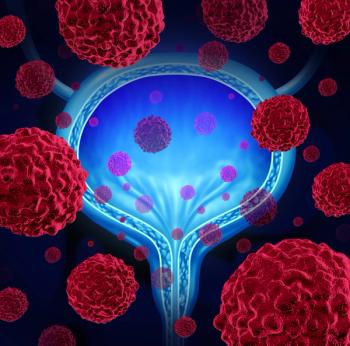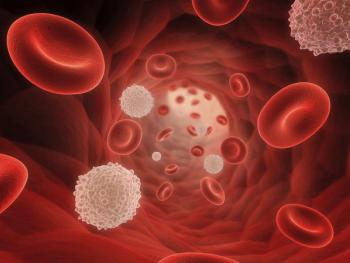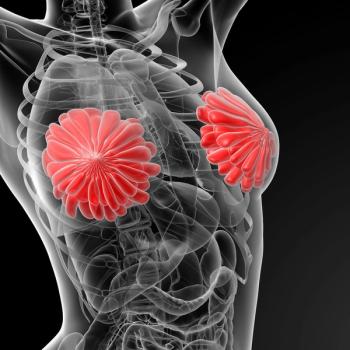
Nivolumab Plus Chemo Improved OS and PFS in Frontline ES-SCLC
The median PFS and OS were 5.5 months and 11.2 months, respectively, with nivolumab plus carboplatin/cisplatin and etoposide in patients with small cell lung cancer.
Nivolumab (Opdivo) plus cisplatin/carboplatin and etoposide prolonged survival, with no new safety signals observed in patients with untreated extensive-stage small cell lung cancer (ES-SCLC), according to results from the randomized phase 2 ECOG-ACRIN EA5161 trial (NCT03382561) published in Cancer.
With a median follow-up of 8.80 months, the median progression-free survival (PFS) was 5.5 months (95% CI, 4.3-5.9) in patients who received nivolumab plus carboplatin/cisplatin and etoposide (arm A) in the trial and 4.9 months (95% CI, 4.5-5.7) in patients who received carboplatin/cisplatin and etoposide alone (arm B) in the trial (1-sided stratified log-rank P = .083). Using the Cox model stratified by gender and lactate dehydrogenase (LDH), the HR of arm A/arm B was 0.78 (95% CI, 0.55-1.11; P = .170)
The median overall survival (OS) was 11.2 months (95% CI, 8.8-14.2) in arm A and 8.1 months (95% CI, 7.2-9.6) in arm B (2-sided stratified log-rank P = .059). Using the Cox model stratified by gender and LDH, the HR of arm A/arm B was 0.71 (95% CI, 0.50-1.02; P = .060).
The overall response rate (ORR) was 77% (n = 58 of 75 patients) in arm A, and 80% (n = 55 of 69) in arm B (1-sided Fisher P = .44). In arm A, complete responses (CRs) were observed in 4 patients, partial responses (PRs) were observed in 54, stable disease in 4, and progressive disease in 6; in arm B, CRs were observed in 5 patients, PRs in 50, stable disease in 4, and progressive disease in 3. The median duration of response (DOR) was 4.12 months (range, 0.49-38.97) in arm A and 3.42 months (range, 1.12-33.28) in arm B.
“In our study of patients with treatment-naive ES-SCLC, the addition of nivolumab plus [carboplatin/cisplatin and etoposide] significantly improved PFS and OS,” wrote lead study author Ticiana A. Leal, MD, associate professor and director of the Thoracic Medical Oncology Program in the Department of Hematology and Medical Oncology at Emory University School of Medicine. “EA5161 adds to the body of evidence, establishing the benefit of immunotherapy in combination with chemotherapy for patients with ES-SCLC in frontline therapy.”
ECOG-ACRIN EA5161 enrolled a total of 160 patients. Patients were randomly assigned to either arm A or arm B. In arm A, they received 360 mg of intravenous nivolumab, carboplatin area under the curve 5 or 6 or 75 mg/m2 of cisplatin, and then etoposide at 100 mg/m2 on days 1 to 3 of every 21-day cycle for up to 4 cycles followed by maintenance with 240 mg of nivolumab given every 2 weeks on a 6-week cycle. In arm B, patients received carboplatin/cisplatin and etoposide in the same dosages and schedule for up to 4 cycles.
Eligible patients were 18 years or older with histologically or cytologically confirmed ES-SCLC, had an ECOG performance status of 0 or 1, and had no prior receipt of systemic treatment for advanced disease; those who received prior chemoradiation treatment with chemotherapy including cisplatin or carboplatin/etoposide for limited-stage SCLC were permitted if they were treated with curative intent at least 6 months since last treatment from diagnosis of ES-SCLC.
The primary end point of the trial was PFS. Secondary end points included OS, ORR, and the toxicity profile of nivolumab with carboplatin/cisplatin and etoposide.
Regarding safety, treatment-related adverse effects (TRAEs) of grade 3 or 4 occurred in 38% and 36% of arm A, respectively. The most common grade 3 TRAEs were decreased neutrophil count (21%), anemia (18%), and fatigue (13%); the most common grade 4 TRAEs were decreased neutrophil count (26%), decreased platelet count (10%), and decreased white blood cell count (10%).
In arm B, grade 3 or 4 TRAEs occurred in 34% and 30%, respectively. The most common grade 3 TRAEs were decreased neutrophil count (23%), anemia (15%), and decreased lymphocyte count (15%); the most common grade 4 TRAEs were decreased neutrophil count (28%), decreased platelet count (7%), and decreased white blood cell count (7%). Treatment discontinuation due to TRAEs occurred in 13% of arm A and 2.7% of arm B.
“Although this study is not intended to lead to an approval of the nivolumab plus [carboplatin/cisplatin and etoposide] regimen given it is phase 2, our data also support future studies investigating this backbone with novel frontline immunotherapy combination strategies,” concluded the study authors.
Reference
Leal TA, Wang Y, Dowlati A, et al. Randomized phase II clinical trial of cisplatin/carboplatin and etoposide (PE) alone or in combination with nivolumab as frontline therapy for extensive-stage small cell lung cancer (ES-SCLC): ECOG-ACRIN EA5161. Cancer. 2025;131(12):e35938. doi:10.1002/cncr.35938
Newsletter
Stay up to date on recent advances in the multidisciplinary approach to cancer.

















































































